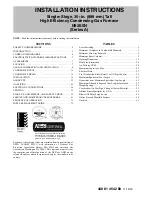
Burner Motor Runs, But . . . (continued)
2 .3
During the 10 second period before
shutdown there is:
a . Check
. The LED code may diagnose the problem .
b . Close the main gas cock (pilot gas cock open) and observe the pilot through the
inspection window as it goes through a sequence .
2 .3 .1
No spark or flame.
a . Close the main gas cock (pilot gas cock open) and observe the pilot through the
inspection window as it goes through a sequence .
b . Remove the burner gun assembly and check for shorted ignition electrode, open
ignition lead, defective ignition transformer, or loose terminal screw on flame
safeguard subbase. Check for voltage between terminal 10 and L2 during the final
10 seconds before the control locks out . If zero voltage, replace the RM7897A .
2 .3 .2
Spark but no flame.
a . Close the main gas cock (pilot gas cock open) and observe the pilot through the
inspection window as it goes through a sequence .
b . Improper pilot and gas adjustments . Connect a manometer to the pilot test tee
and adjust per
Pilot Air & Gas Adjustments on page 16
. If the specified settings
cannot be attained, a problem is indicated .
2 .4 Improper pilot air readings .
a . The pilot air pickup tube is not inserted into the blower housing, is broken, cracked,
kinked, or improperly positioned .
b . Plugged air tube .
c . Tubing to the pilot burner is not connected, is loose or cracked .
d. Plugged pilot gas orifice.
2 .5 Proper pilot air and gas readings,
spark but no pilot flame.
a. Porcelain sleeve around ignition electrode is not adequately reducing airflow
through this opening . See
Ignition Electrode Adjustments on page 16
b . Air in gas lines as a result of inadequate bleeding or recent service work or
construction .
c . Readjustment of pilot air and gas is required . Refer to “Pilot Air and Gas
Adjustment” section .
2.6 Pilot flame comes on, but flame
safeguard still locks out .
a. The flame safeguard is not detecting pilot flame. Check flame safeguard using
. If this confirms flame safeguard is working, and the pilot is coming
on during the 10 second ignition trial period, then the pilot is not producing an
adequate flame signal. Check pilot and its adjustments as listed above in 2.6-b, c
and d .
b. Disconnected, shorted or open flame rod lead.
Motor Runs, Pilot Ignites . . .
3 .1 Burner motor starts . After 30 (60 or
90) seconds the PILOT LED comes
on, the FLAME LED comes on
momentarily and then goes out .
a . Check
. The LED code may diagnose the problem .
b. The power is only momentarily proving itself to the flame safeguard. It must be
proven at the end of the of the 10 second ignition trial .
c. On a new start-up, this could indicate the gas lines have not been sufficiently
purged of air .
d. Improper flame rod position.
e . Improper pilot air or gas adjustments .
f . Air leakage into the pilot burner at the porcelain bushing or through cracks in pilot
burner .
g . Defective or improperly installed pressure regulator upstream of pilot gas cock
that passes enough gas for pilot, but when main valve opens, gas pressure drops
drastically .
3.2 Pilot operates, the flame safeguard
does not lock out . but the main
flame does not come on.
a . Check
. The LED code may diagnose the problem .
b . Check that the main manual gas cocks are open .
c . If the Main LED does not come on, check the voltage at terminals 9 to L2 . If no
voltage across 9 to L2, replace the RM7897A .
d . Check for defective or improperly installed pressure regulators and determine that
their vents are not plugged .
e . Check for defective or improperly installed main gas valves, or open wires to the
valve .
f. On diaphragm type gas valves, check for plugged or misadjusted bleed orifice or
bleed line .
Troubleshooting
www .DaikinApplied .com 27
IM 684-6 • ROOFTOP SYSTEMS












































